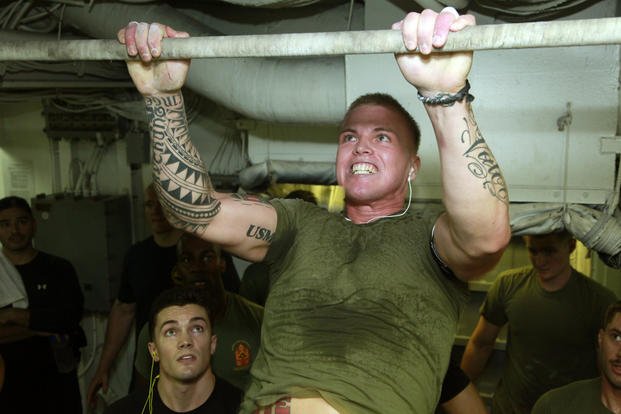The pull-up is considered the heavy weightlifting exercise of the calisthenics world. When you're doing them properly, nearly 100% of your body weight is pulled off the ground and over a bar.
Besides being a tough and challenging exercise that makes a great fitness goal for anyone, doing pull-ups will help you in many activities required for anyone serving in the military or other tactical profession.
Here is an email from a young man seeking to serve but currently is failing at pull-ups:
Stew, I am having a problem with pull-ups. I cannot do any! In the workouts I follow, they list pull-ups as an exercise. Do you have any advice for other exercises I can use as a replacement and will also help me be able to do them later? Looking at my fitness tests, I do not think I will be tested in pull-ups for the job I want. Why do I need to do them in the first place? From, Joe (future Air Force)
It is true that most fitness tests in the military do not require pull-ups. Even the Marine Corps, which does test pull-ups, allows recruits and service members to replace them with push-ups if pull-ups prove too difficult.
However, you will need to develop a level of upper-body strength from pulling exercises for the following type of obstacles.
Basic training
You may see rope climbs and even pull-up tests in your basic military training. The pull-up is one of those exercises that separates the outstanding candidates from the crowd by testing a level of performance that not many can master. There are fitness awards in your training class -- Warhawk and Thunderbolt -- that will require pull-ups and maximize the standard events of the PT Test (push-ups, sit-ups, 1.5-mile or two-mile run).
Obstacle courses
You will see a variety of obstacle courses in your military journey. Depending on the branch of service, these courses may require you to climb over a wall or fence, or shimmy up a rope. These activities use the same muscle groups (biceps, lats, rear shoulders and forearms) that pull-ups help develop.
Career changes
If you challenge yourself one day and apply for a special operations job or a support job within Special Operations Command, you undoubtedly will be required to do multiple repetitions of a pull-up to be competitive.
Be an asset
This is the most important reason why pull-ups are important. Having the type of upper-body strength required to do a pull-up may be the very thing you need in an emergency when your grip is needed to carry or drag someone to safety. In a dangerous situation, you may need to pull yourself up and over a vertical ledge or help someone over an obstacle.
Getting Better at Pull-ups
Men and women who regularly exercise and do upper-body days eventually can do pull-ups. Consistent upper-body training (at least two and preferably three times a week) is the best way to improve. Getting your first pull-up is the hardest. After your first pull-up, double-digit reps are not far away if you keep up the training routine.
Here is a list of exercises that will help you get to your first pull-up.
Assisted pull-ups
If you cannot do pull-ups, do assisted ones using rubber bands, a spotting partner, Gravitron or pull-down machines to start building your muscles. Eventually, you will need to expose your arms to your full body weight to progress to a real pull-up.
Hanging from the bar
By hanging on the bar, you will build your grip and get your arms used to your body weight. Strive to flex the shoulders and start with the beginning of the pull-up lift.
Jumping pull-ups and negatives
Get yourself over the bar any way you can by jumping, stepping onto a bench or getting an assist from a partner. Then slowly let yourself down, fighting gravity for a count of five seconds (or longer) if you can. Once you no longer can control your descent, do not do this option.
Weights
Working other pulling muscles of the back (lats, rear deltoids) and the biceps will help you develop the pulling and grip muscles needed to do a pull-up.
One of my favorite circuits is a descending difficulty pulling circuit.
Repeat three times.
- Run or bike five minutes
- Pull-ups: Try one
- Negative pull-up: 1-2. Get up, then controlled five-second descents
- Pull-downs: 5-10 (but moderately heavy so this is difficult)
- Dumbbell rows: 5-10 (but moderately heavy so this is difficult)
- Biceps curls: 10
By the time you get to your biceps curls, you likely will have little left in the tank, so just top off the circuit with a light set of curls, then repeat by "resting with cardio for five minutes" before each round of pulling exercises.
One final piece of advice is to lose weight if you have it to lose. Pull-ups as well as many other events, such as running, push-ups and obstacle courses, will be easier if you weigh less.
Stew Smith is a former Navy SEAL and fitness author certified as a Strength and Conditioning Specialist (CSCS) with the National Strength and Conditioning Association. Visit his Fitness eBook store if you're looking to start a workout program to create a healthy lifestyle. Send your fitness questions to stew@stewsmith.com.
Want to Learn More About Military Life?
Whether you're thinking of joining the military, looking for fitness and basic training tips, or keeping up with military life and benefits, Military.com has you covered. Subscribe to Military.com to have military news, updates and resources delivered directly to your inbox.



















